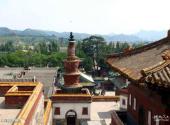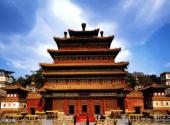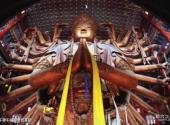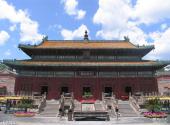
Scenic spot introduction:
Puning Temple, the largest Tibetan Buddhist activity venue in northern China, is located on the bank of the Wulie River in the north of the Summer Resort in Chengde City. Because there is a gold-lacquered wooden Buddha in the temple, it is commonly known as the Big Buddha Temple. Puning Temple was built in the 24th year of Qianlong (1759), covering an area of 33,000 square meters. It is the most complete and spectacular temple complex among the eight outer temples. The main Buddha statue of Puning Temple, Avalokitesvara Bodhisattva with Thousand Arms and Thousand Eyes, is the largest wooden Buddha statue in the world and has been included in the Guinness World Records.Attractions distribution:
The temple has 29 halls, pavilions and various buildings. The layout of the temple integrating emperor and Buddha makes it not only the grand scale of a resplendent royal temple, but also the "center of the Mandala Buddha World", a Buddhist holy land. The entire temple has a rigorous layout, with the Main Hall as the boundary, and is divided into two parts, the front and back. The first half is the traditional Jialan seven-hall layout of Han temples, and the second half is in Tibetan style, with a mandala built in the style of the Tibetan Samaya Temple. Luo, the Thousand-Armed, Thousand-Eyed Avalokitesvara Bodhisattva is enshrined in the Mahayana Pavilion of the main building.Scenic spot qualifications:
National 4A level scenic spot, world cultural heritage, national key cultural relics protection unitScenic spot features:
A combination of Chinese and Tibetan temple architecture, the largest wooden Buddha statue in the world, and a templetravelling guideline:
October 25 of the lunar calendar is the death day of Tsongkhapa, the founder of the Gelug sect of Tibetan Buddhism. In order to promote Buddhism and benefit sentient beings, the monks of Puning Temple held a Thousand-Offering Dharma Assembly for the Lantern Festival on December 15, 2006 (the 25th day of the tenth lunar month).
During the Lantern Festival, along with the Dharma chants, the sound of Dharma conches and golden suonas, monks lit lamps on both sides of the road, around pagodas, on the roofs of halls, windowsills, indoor Buddhist halls, Buddhist niches, offering tables, etc., as well as everywhere. On the steps, butter lamps are lit, and a bowl of pure water is offered in the temple. The lamps and water complement each other, making the pagodas, temples, temples and houses brightly lit. Tens of thousands of butter Buddha lamps are shining with golden light. Looking from a distance, the lamps arranged in a line or in the shape of a pagoda are like stars falling to the ground, illuminating the night sky brightly. The temple is crowded with people watching lanterns and worshiping Buddha to commemorate Master Tsongkhapa.
Best time to visit:
May, October
Shopping recommendations:
Bracken, Lulu, Teng's cloth paintings, Chengde wood carvings, hanging brocades, flower rose cakes, paper cutting, Fengning cloth paintings
Scenic spot location:
China > Hebei Province > Chengde City > Shuangqiao District
How to get there:
Bus: Bus No. 6 arrives at Puning Temple. Taxis cost up to 10 yuan if starting from the main entrance of the villa. Putuo Zongcheng Temple and Xumi Fushou Temple can be reached by Route 118 (also called 18 Puning Temple Road). If you take a taxi from the main entrance of the villa, the maximum is 10 yuan, and a taxi between the two temples and Puning Temple is 5 yuan. Anyuan Temple and Pule Temple of Qingchui Peak can be reached by Route 10. If you take a taxi from the main entrance of the villa, it costs 5 to 10 yuan, and a taxi between Puning Temple and Putuo Zong takes 5 yuan.
Self-driving route: Chengde City, Hebei Province 1. Go north and go to South Xinglong Street for 200 meters 2. Turn right at South Xinglong Street for 140 meters 3. Turn right at intersection 1 towards Lizhengmen Street Go 290 meters 4. Turn slightly left at the Dehuimen intersection and enter Shanzhuang East Road 300 meters 5. Take exit 1 of the roundabout and go to Songhe Bridge 350 meters 6. Turn left at Huancheng East Road/354 Provincial Road and continue along 354 Go straight on the provincial highway for 2.9 kilometers 7. Drive 500 meters from Exit 1 of the roundabout 8. Turn right on Puning Road for 1.2 kilometers 9. Turn right for 220 meters to reach the scenic spot.
Scenic area map:
Click to expand the scenic area map
Puning Temple ticket price:
80 yuan in peak season (April 1st - October 31st)
60 yuan in off-season (November 1st - March 31st of the following year)
Scenic area opening hours:
6:00 to 18:00
The opening hours of the scenic spot will change with the seasons.





